Grasshopper are the most successful team in Swiss football, with 27 league titles to their name — seven more than second-placed FC Basel. They are also without a title win since 2003, with this past season marking an unfortunate two-decade span without a triumph in the league.
The Zürich-based club even spent a couple of seasons in the second-tier not-so-long-ago — the 2019/20 and 2020/21 campaigns — during which they competed with a certain SC Kriens under the tutelage of one Bruno Berner.
The former left-back — who played in the Super League with both Grasshopper and FC Basel, the EPL with Blackburn Rovers, EFL Championship with Leicester City and German Bundesliga with SC Freiburg during a reasonably successful playing career that saw him win two Super Leagues, one EFL League One, one Swiss Cup and one 2. Bundesliga — helped Kriens to reach the second tier in 2017/18.
After this, as detailed in a Sky Sports report and interview looking at the coach who managed part-time players in a full-time league, there was a lack of significant investment in the playing squad. As a result, he was taking players with day jobs off on weekend trips to compete with the likes of Grasshopper — a team packed with relative superstars in comparison to Kriens.
Still, Berner kept Kriens in the second tier for three straight seasons before he departed for the Swiss U19s, and the team of part-timers would be relegated the following campaign.
There’s a famous quote from ex-FC Bayern boss Julian Nagelsmann: “Thirty% of coaching is tactics, 70% social competence… Every player is motivated by different things and needs to be addressed accordingly.” Berner praised the impact of his time at Kriens on the social competence aspect of his coaching in the aforementioned Sky Sports interview:
“You prepare the session, and a few hours before, you have three players texting you that they cannot come in because they have to work longer. What are you going to do? Do you tell them they are out of the team? They are in a job, and you have to accept it. Patience had been a weakness, but I learned from that and became able to adapt very quickly to situations. It was so much easier to manage in a game because it felt like I never knew what was around the corner during the week, either. Dealing with it became normal.”
Berner’s time at Kriens undoubtedly helped prepare him for an opportunity to coach in Switzerland’s top-tier, which he got last year with Winterthur. Per Transfermarkt, they were the least-valuable squad in the Super League by some distance. However, he successfully guided them to safety and will compete with them in the league again this season, though now he’s in charge of fallen giant Grasshopper.
The famous Zürich-based club finished seventh last season, just two places ahead of Winterthur. They’ve currently got the fifth-least valuable squad in Switzerland’s top flight, though that’s still 1.5x as valuable as Winterthur’s current squad value, for reference.
The historical expectation of managing a club like Grasshopper is heavy. However, with their success falling off over the past two decades and relegation even occurring in very recent times, managing the Zürich outfit is a different prospect from what it once was and will be approached accordingly. Still, this is the biggest club Berner has managed so far in his coaching career and may provide him with an excellent opportunity to display his skills on an even greater level than he has in the past.
Can the serial overachiever do it again and, perhaps, get Grasshopper competing in the top half of the table or upper end of the table? What can be expected of the promising 45-year-old coach at Stadion Letzigrund? This tactical analysis will look at Berner’s typical tactical approach based on his past clubs, including Winterthur. Via analysis of his previously-used strategies and tactics, we’ll formulate some ideas of what Grasshopper supporters can expect to see from their team this term.
In possession
Let’s begin by looking at Winterthur in possession last season. They ended the campaign, unsurprisingly, with the lowest possession in the Swiss Super League (41.2%), the fewest shots (8.56 per 90), the lowest xG (34.09), the fewest goals (32) and lowest xG per shot (0.103).
None of this is particularly appealing and nothing Grasshopper will strive for. However, with a far stronger squad, Grasshopper didn’t do much better in many of these areas last season.
They were pretty stylistically similar to Winterthur across the board and performed to a similar level. They finished the season with the second-lowest possession (46.5%), second-fewest shots (9.58 per 90), third-lowest xG (47.91), fourth-most goals (56) and fifth-highest xG per shot (0.129).
So, an overperformance in front of goal helped Grasshopper massively to finish two places above Winterthur last term. They were pretty good at generating decent-quality chances but weren’t generating enough opportunities overall.
Berner will hope to increase their shots per 90 without compromising on xG per shot. If he can achieve that, it may be possible for Grasshopper to achieve similar goalscoring numbers to last season or even surpass them despite their big xG overperformance in 2022/23.

Last season, Winterthur’s right centre-back, Yannick Schmid, played an important role in progressing his team upfield. He demonstrated good, reliable progressive passing ability, which helped his team to transition to attack or create micro transitions versus an aggressive opposition press, quickly progressing from build-up, through progression and into chance creation in the blink of an eye.
We see an example of Winterthur drawing the opposition’s press via some deep possession play, progressing through the right centre-back and into midfield where, thanks to some excellent off-the-ball movement and intelligent link-up play, Winterthur are able to split the opposition open and set themselves up nicely to progress into the final third.
This idea of attracting the opposition’s press and finding a pathway to play through them via the right centre-back’s passing ability — and active movement into space to give him options from the more advanced players in front — was a common sight when watching Berner’s team last season. Opposing teams frequently pressed high against them, meaning they could pull off this type of strategy with regularity.
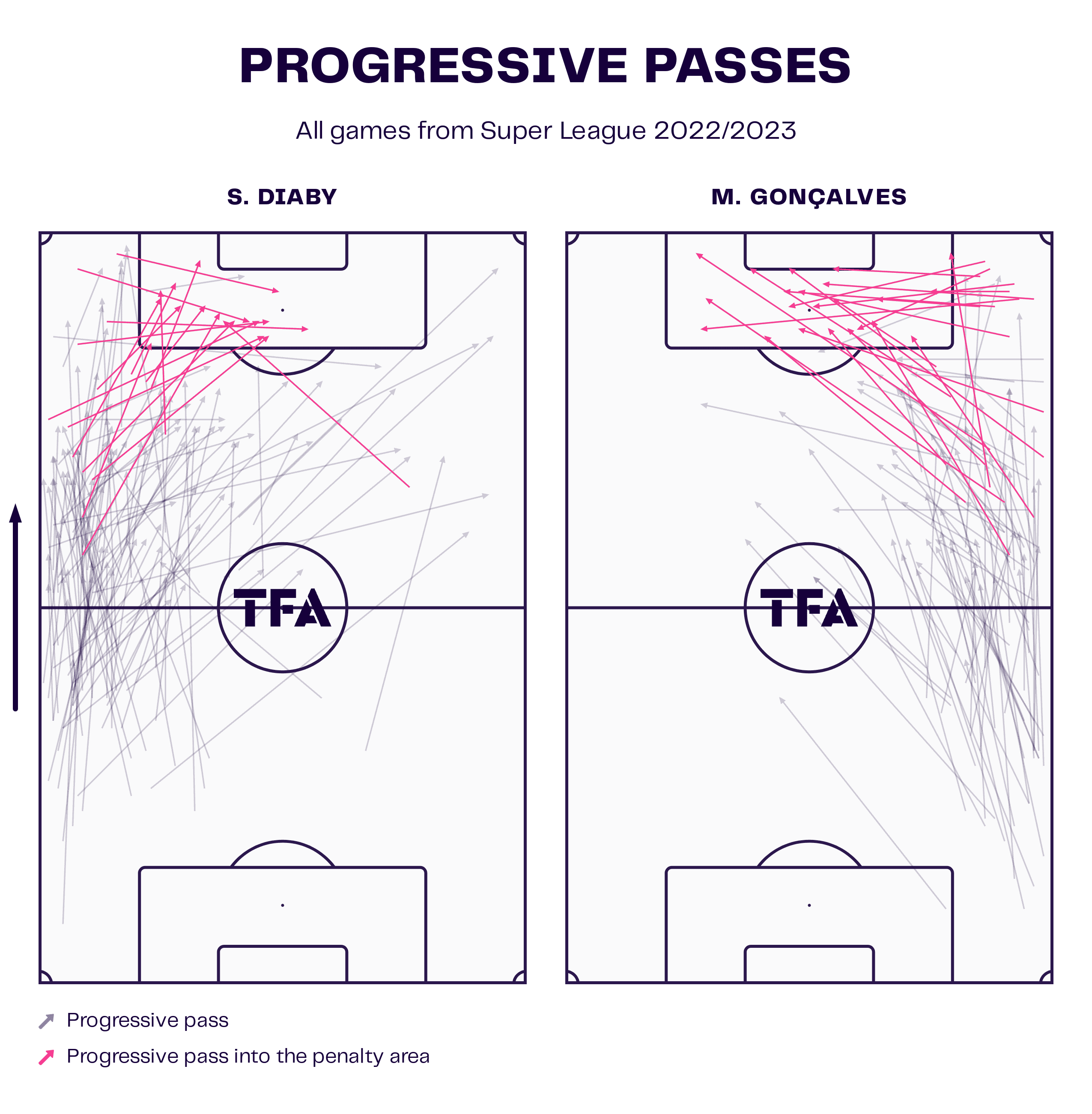
Winterthur’s full-backs — Souleymane Diaby on the left and Michael Gonçalves on the right — were also vital to the team’s ball progression for similar reasons as listed before. As teams pressed Winterthur high, they often packed the centre to ensure they limited space for Berner’s side to progress through this valuable area.
This, then, left more space open out in the wide areas, where Winterthur could play the ball to one of the full-backs with time and space to get moving upfield. The two full-backs progressed the ball in quite different ways, however, as figure 2 above highlights.
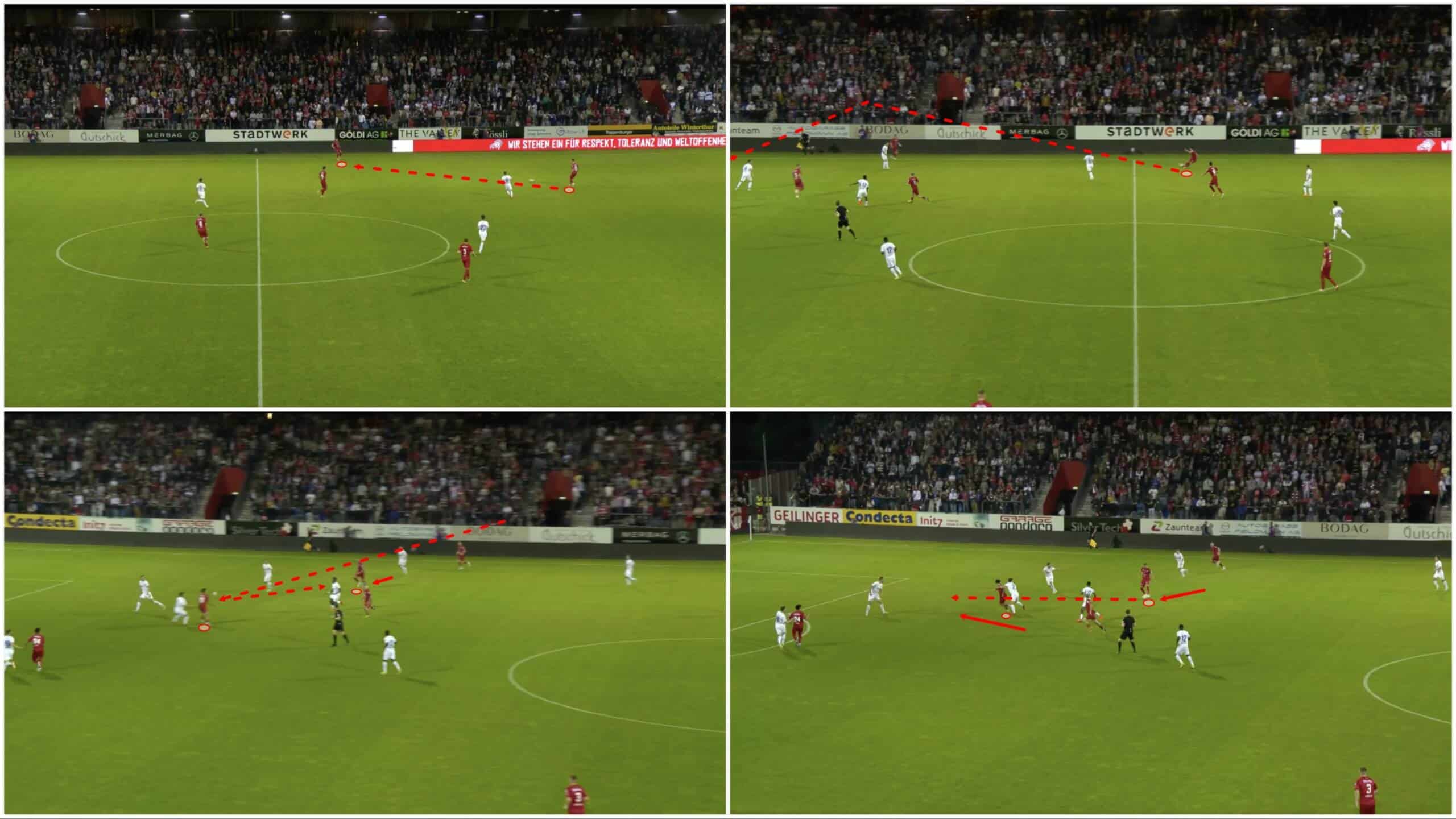
Gonçalves tended to play more long balls and essentially acted as a deep-lying playmaker from the wider areas. When he got the ball in space deep when playing against an aggressive press, he wouldn’t look to carry the ball forward. Instead, he’d get his head up and try to pick out a pass to a teammate in space in a more advanced position, as figure 3 demonstrates.
In this case, the right-back sent a big long ball forward, met a teammate at chest height who was able to knock the ball down for another Winterthur player to collect the second ball and split the defence open with a through pass for the same player who’d just chested the ball to him to chase in behind.
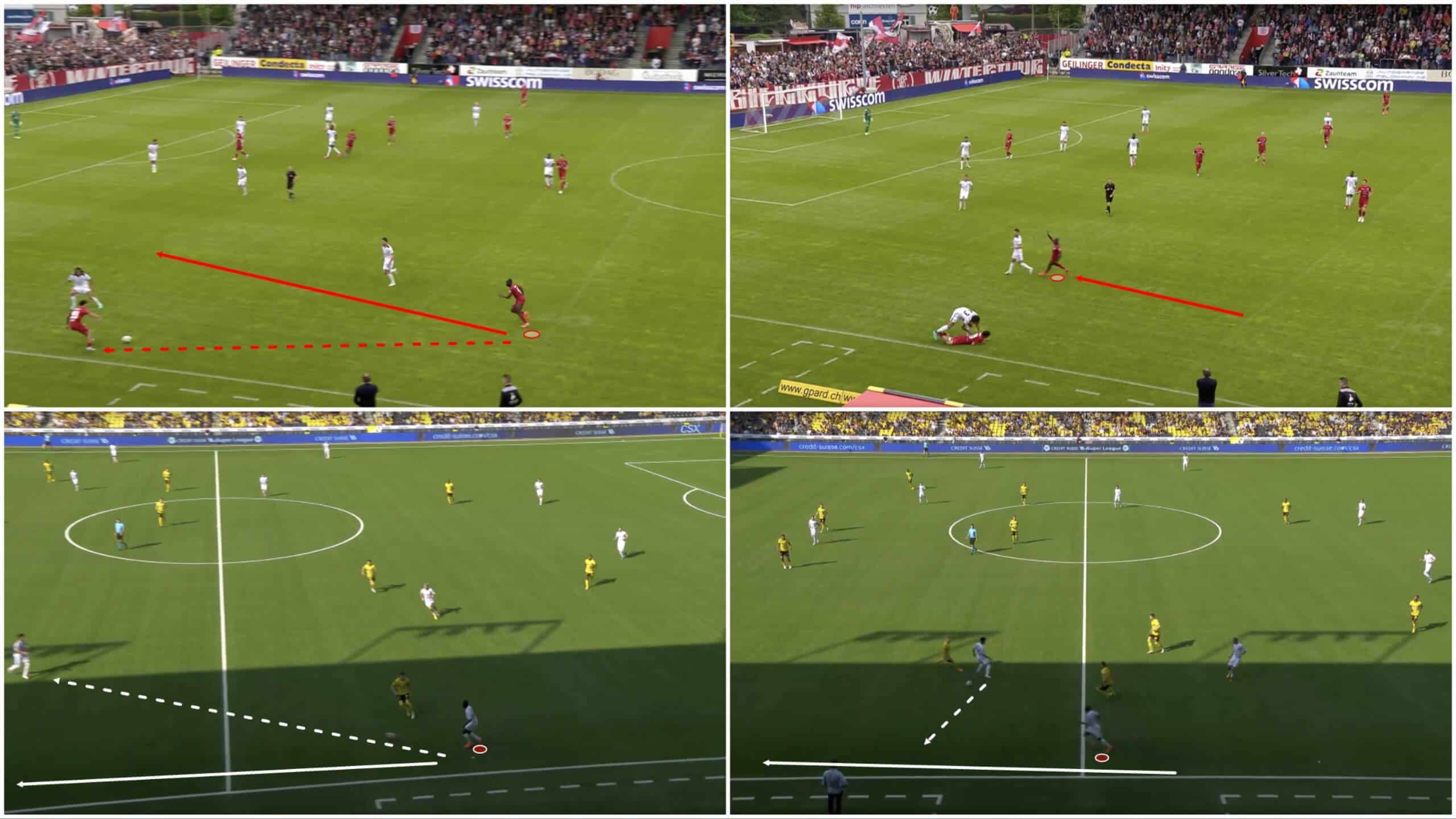
Diaby, meanwhile, tended to play a lot more give-and-go passes. One-twos along the left wing, whether they entailed the full-back making an overlapping run or an underlapping run, were commonplace within Winterthur’s game plan. We see a couple of examples of this — one underlap and one overlap — in figure 4.
Again, this helped Winterthur quickly exploit space resulting from the opposition’s high press. Diaby’s initial pass, for instance, in the bottom-left picture, saw the receiver dropping into space to receive to feet. This dragged the opposition right-back up with him and created space for the left-back to drive into behind the opponent.
All of these ball progression examples highlight how Berner and his squad created lots of different solutions to beating the high press and exposing the aggressive backline. They are examples of the practical, direct and fluid ball progression that was key to Berner’s team on the ball in 2022/23.
The 45-year-old coach explained that his time at Kriens helped him to become more creative as a coach, and ideas like these we saw last season to help Winterthur outperform their abilities in possession and quickly progress towards the opposition’s goal are evidence of this.
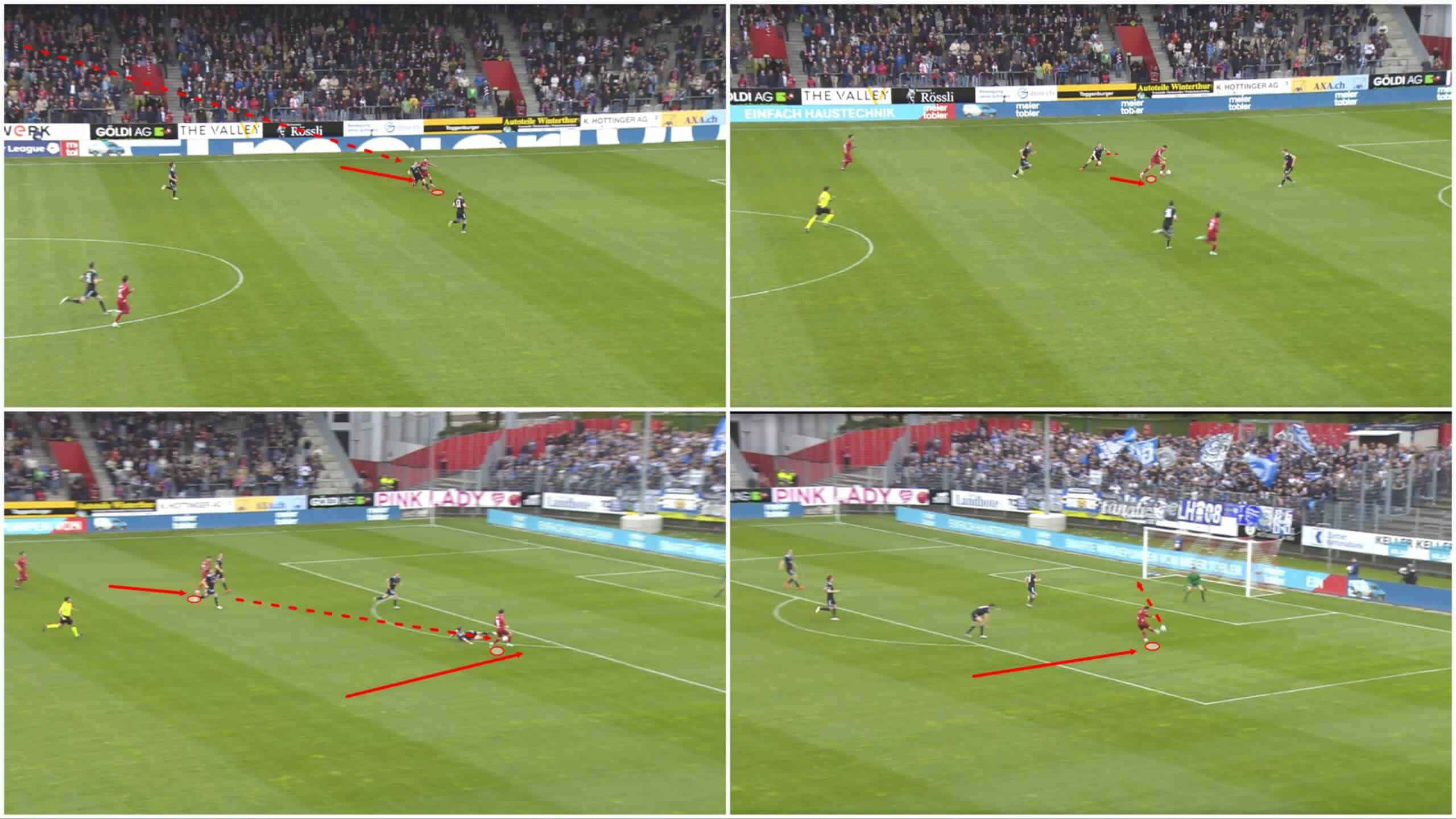
Up front, Winterthur made great use of 186cm/6’1″ Joaquín Ardaiz. He often had to feed off of inaccurate long balls, chase them down and fight defenders to be the first man to the ball, which we see an example of in figure 5 above.
The centre-forward used his strength to push the competing centre-back away and create some space for himself on the ball. He could carry it forward and set up a teammate with a through pass. Although the resulting shot is put wide of the mark, this is still an excellent example of how many of Winterthur’s chances came about last season.
Runs from a physical centre-forward like Ardaiz into the channels and physical battles chasing down the ball were commonplace. This required a solid offensive work ethic from the centre-forward — a player who, again, had to chase balls all around the final third from deep and use his strength to battle with centre-backs and create space for himself to create something on the ball.
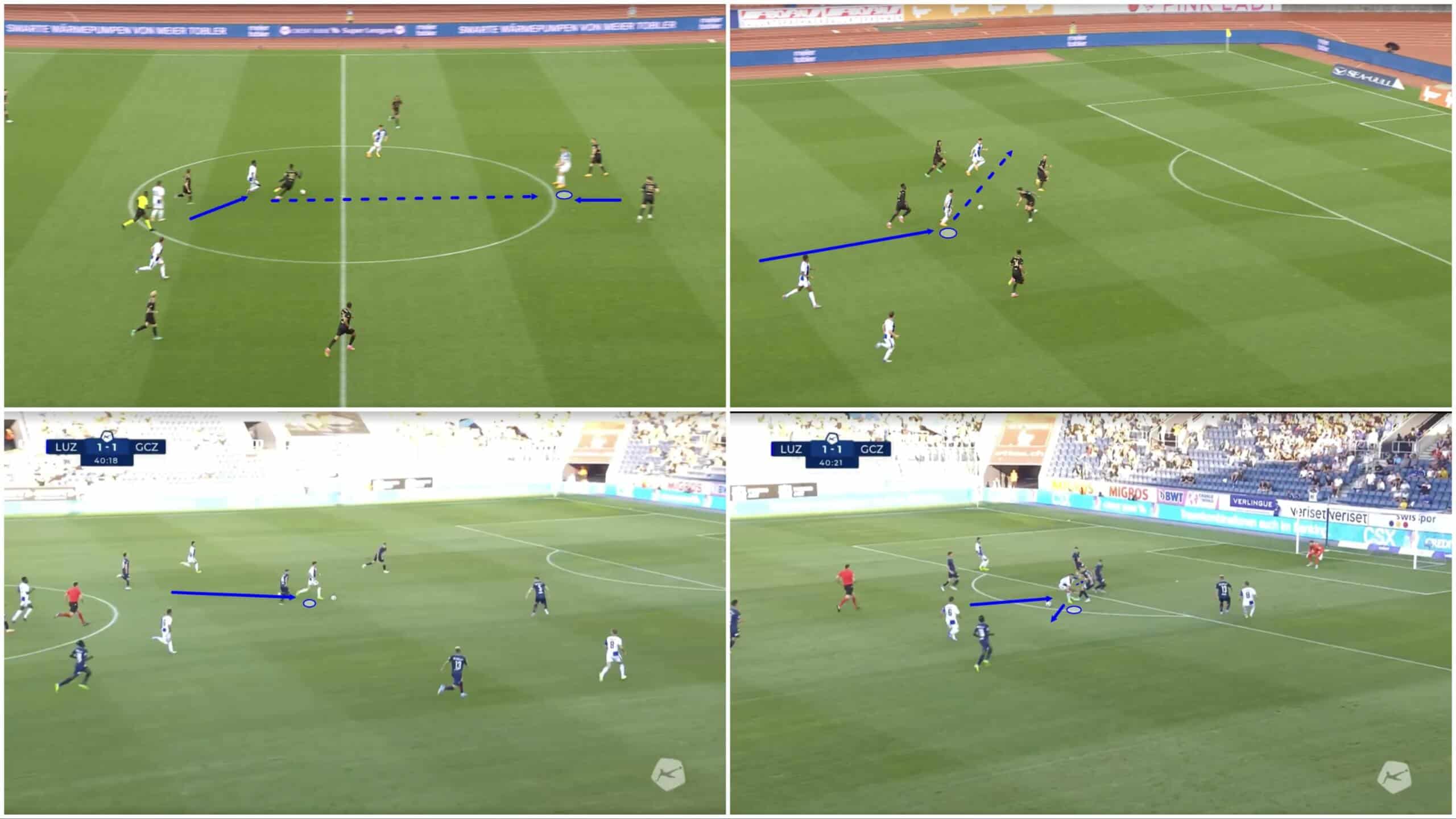
Grasshopper have a centre-forward capable of playing in this manner to an even greater extent in Azerbaijan international Renat Dadashov (187cm/6’1″), who scored eight league goals and provided five league assists last term.
Figure 6 shows a couple of examples of Dadashov’s attacking game. Firstly, in the top half, we see Dadashov having dropped deep to receive to feet from a ball-carrying midfielder. He’s able to take it on the half-turn and drive forward a few steps before laying it off into a nearby runner’s path.
Dadashov is very capable on the ball and frequently displays deceptively quick and quite agile movement when receiving after dropping deep. He’s good at providing the midfielder’s with a short passing option and dragging centre-backs away from their deep positions, creating space in behind for the team to target — space which Berner is excellent at helping to come up with creative ways of attacking.
In the bottom example, we see an example of the striker carrying the ball forward into the final third. On reaching the edge of the box, the forward stops and turns, using his body as a bit of a battering ram to shoulder the nearest defender away (which also helps him to turn more fluidly), creating space for himself on the ball, holding up the play and giving himself time to survey the situation and get better options from his teammates.
Dadashov is good at creating this time and space for himself to hold up the play by shouldering opponents away and getting his head up to make something happen. Whether it’s via a short pass into feet or a long ball played into the attack for the player to work for, expect to see Dadashov’s combination of physicality and technical quality to be a key asset for Berner’s Grasshopper side this season.
Out of possession
Again, Winterthur and Grasshopper played fairly similarly without the ball last season. Neither team pressed very aggressively, with Winterthur having the highest PPDA in the league (13.25) and Grasshopper having the fourth-highest PPDA (10.41), as well as Winterthur having the lowest challenge intensity (5.2) and Grasshopper having the third-lowest (5.8).
Both teams preferred a less aggressive defensive approach, in general. Interestingly, Berner’s Winterthur were far better at denying the opposition shots than Grasshopper were. The 45-year-old’s side ended the season with the fourth-highest shots against per 90 (12.51), but Grasshopper had the highest shots against per 90 at 14.72.
On top of that, Winterthur generated the fifth-lowest xGA per shot (0.124) compared to Grasshopper, who had the third-highest at 0.134. In the end, Winterthur — despite their lower squad value and overall lower quality — ended the season with 59.63 xGA, which was far lower than Grasshopper’s staggering 76.2 xGA.
Yet again, the Zürich-based club overperformed the expected numbers here, as they only actually conceded 64 goals. Meanwhile, Winterthur conceded 66, underperforming the expected numbers. Once more, we see a big overperformance helping Grasshopper to finish above Winterthur last term.
Now with Grasshopper, Berner’s biggest task may be to lower the xGA. He will be hoping to concede fewer shots in total and reduce the quality of shots they’ve been conceding, as the current rate of both — especially when put together — is unsustainable for a club that would hope to be moving up the table and competing in the top-half at a minimum.
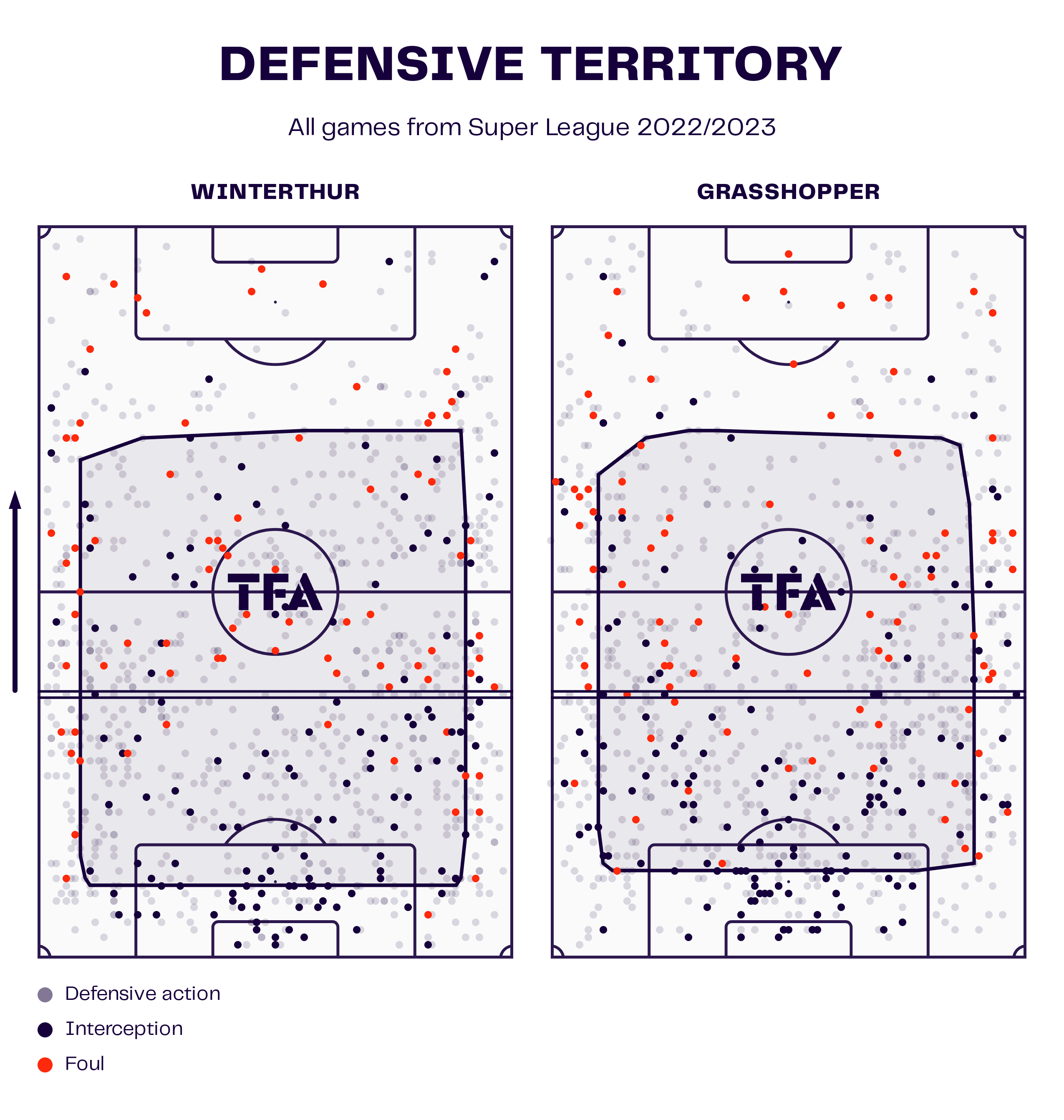
Here, we have both teams’ defensive territory from last season. Both defended somewhat similarly in terms of area and the height of their respective backlines. One key difference between the two teams’ defensive approaches is where they tended to engage their opponents in defensive actions.
For Berner’s Winterthur, the wingers and full-backs were the primary players to engage in defensive duels and perform interceptions. They were the main aggressors in the side. This was a result of the team’s defensive tactics, which saw them aim to deny the opposition any access to the centre of the pitch, force the play out wide and engage there once in what they’d deem a safer region of the pitch to commit to the duel.
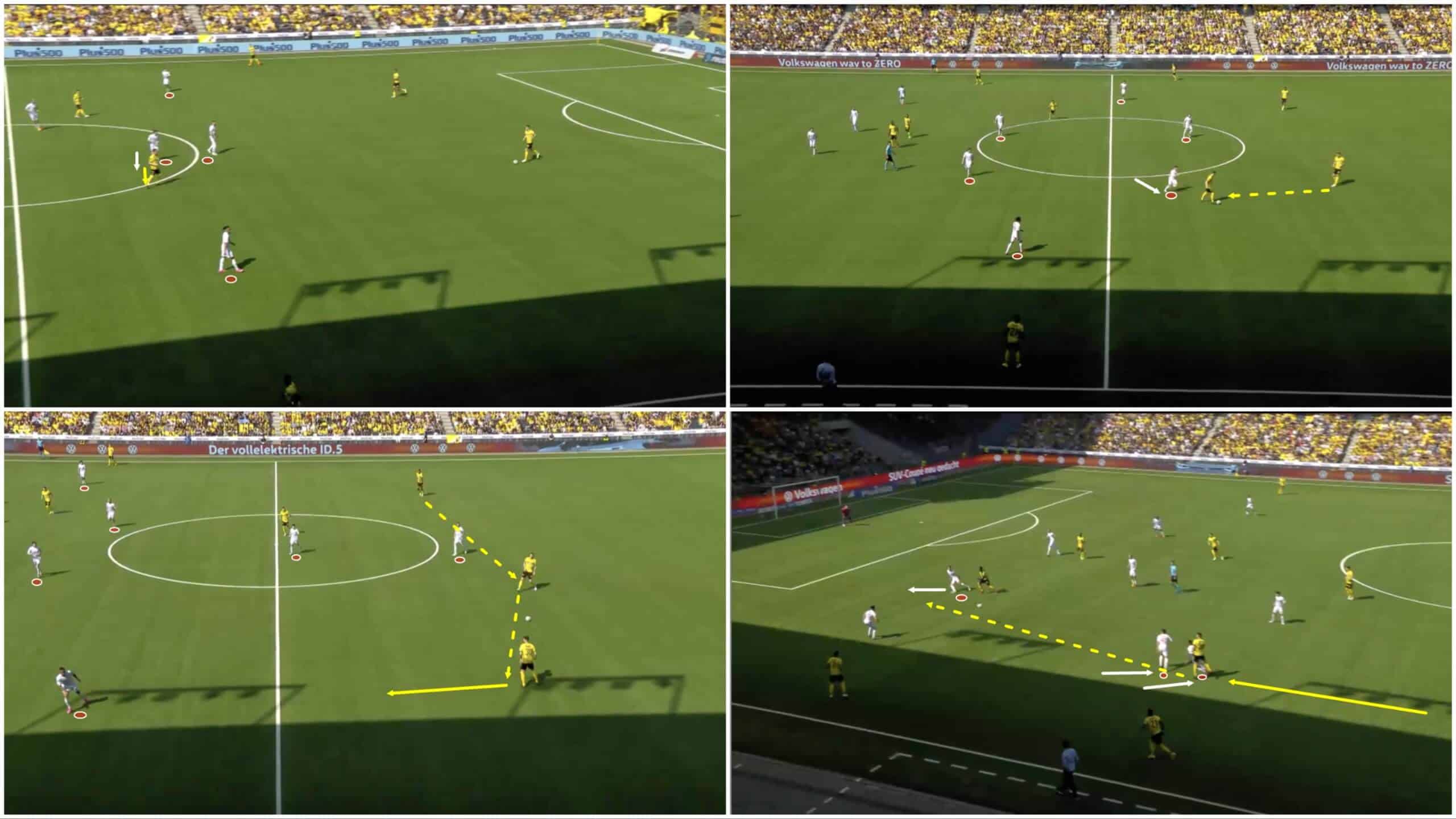
We can see an example of this in figure 8. Firstly, note the defensive shape. Berner favours a 4-2-3-1, as we see here, or a 4-4-2. Both are standard systems to see the coach utilise. His four-player midfield will be narrow as he looks to congest the centre and deny the opposition space to progress into.
Note the attacking midfielder’s marking. He follows the opposition’s holding midfielder, ensuring this player, in particular, is denied any space to receive, turn and play the ball forward. This is to ensure that this player in a precious area of the pitch is inaccessible.
Of course, with man-marking, the player’s positioning can be manipulated; this is always a risk with such an approach. However, Berner likes the opposition’s holding midfielder to be tracked all around the centre of the pitch by his ’10’, regardless of whether he stays central or moves to the left or right.
Here, as the holding midfielder receives, he’s forced to play back to the defence, and after a couple of passes, the ball ends up returning to the left side of the pitch, where the opposition finally decides to try and move forward.
As soon as they enter Winterthur’s half on the left side, the pressure increases massively, with the left winger jumping into play.
It can’t be stressed enough how important the defensive work rate from Berner’s wingers is to the success of his system. He’s built a coaching career by making a unit that’s greater than the sum of its parts, and one key ingredient to his formula is having 100% commitment without the ball from everyone. Due to his defensive system, the wingers are often in positions requiring them to press aggressively, so Grasshopper’s wingers will need to be prepared to work like dogs without the ball this season, or they will be benched.
As the pressure increases here, the frustrated opponent fires a ball forward for an attacker to chase, but it’s far closer to the Winterthur defender, who can clean up and restart possession for Berner’s team.
On the other hand, Grasshopper tended to try and press from out-to-in last season, using central pressing traps quite frequently in their attempts to catch the opposition out in their progression attempts and win the ball back as the opponent played into midfield. This saw Grasshopper’s central midfielders carry the primary pressing duties a lot of the time last term.
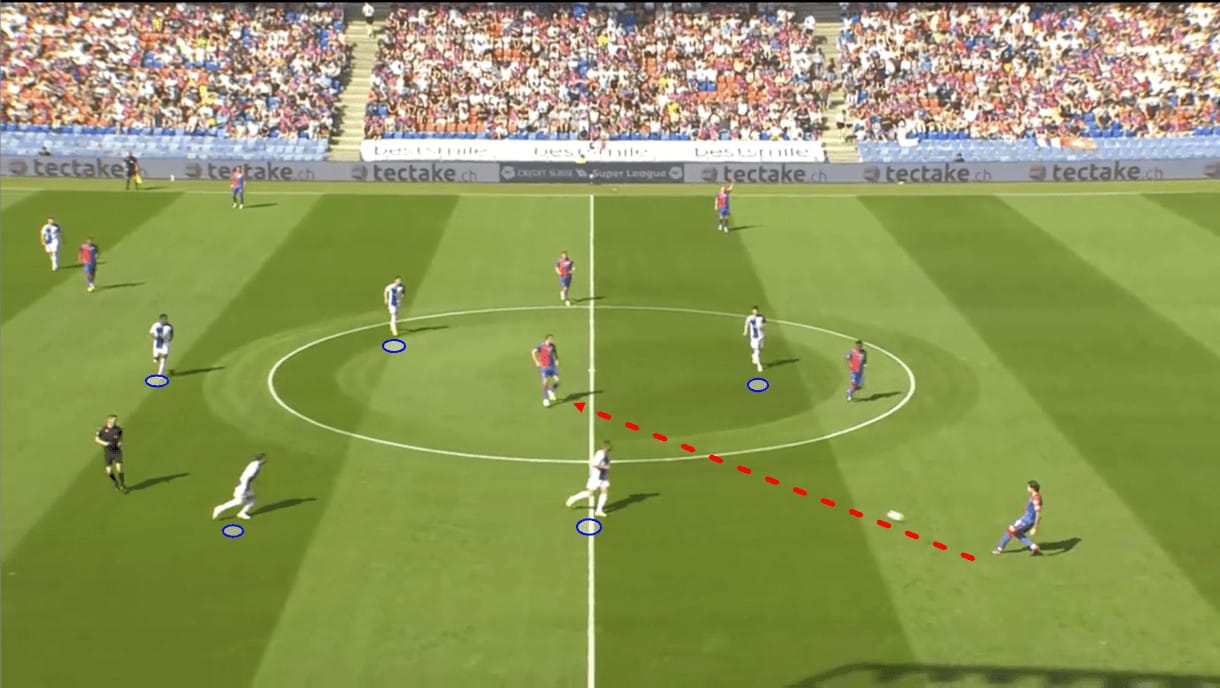
Grasshopper used various defensive systems last season, including the ones we mentioned as Berner’s most common, but also three-at-the-back shapes as they searched for the best possible solution to their defensive problems. In our example, we see them playing with a 5-3-2 shape.
Regardless, the strategy in terms of pressing and the idea of setting central pressing traps remained reasonably consistent.
Here, we see an example: the strikers not closing off the pass into midfield at all, but the central midfielders bracing themselves to jump into action as soon as the ball is played.
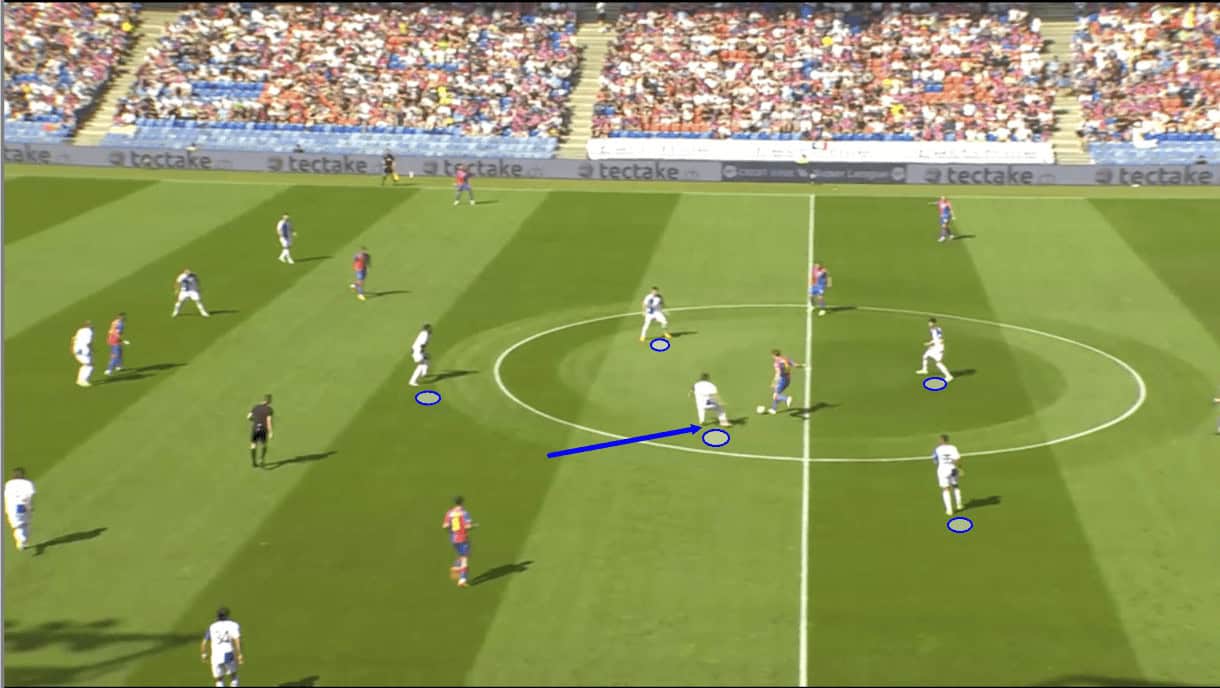
As play moves on into figure 10, we see a clear example of Grasshopper’s idea in action, as the receiver turns but is met by a less-than-ideal sight. However, the midfielder didn’t arrive quickly enough to dispossess the opposition midfielder, who still had time to play the ball out to the wing, where his team could continue their attack.
This is to highlight the contrasting defensive tactics deployed by Berner and Grasshopper last season. This term, I’d expect to see Grasshopper defend more in the fashion that Winterthur did last season, especially with Berner’s side enjoying a more impressive defensive record in terms of xGA, shots against and xG per shot against.
It’s clear that Grasshopper’s defence is in need of a complete overhaul, and Berner may be the right man to perform the necessary surgery.
Key new signings
Plenty of Grasshopper’s key players, including goalkeeper André Moreira, left-back/left-winger Dominik Schmid, centre-back Tomás Ribeiro, centre-back Georg Margreitter and central midfielder Hayao Kawabe have left the club ahead of the 2023/24 season. This opens the way for fresh faces at Stadion Letzigrund, who could offer fresh hope to the Grasshopper faithful.
In this final section, we’re going to run through a few of the Zürich-based club’s most interesting summer signings and highlight how they may fit into Berner’s vision.
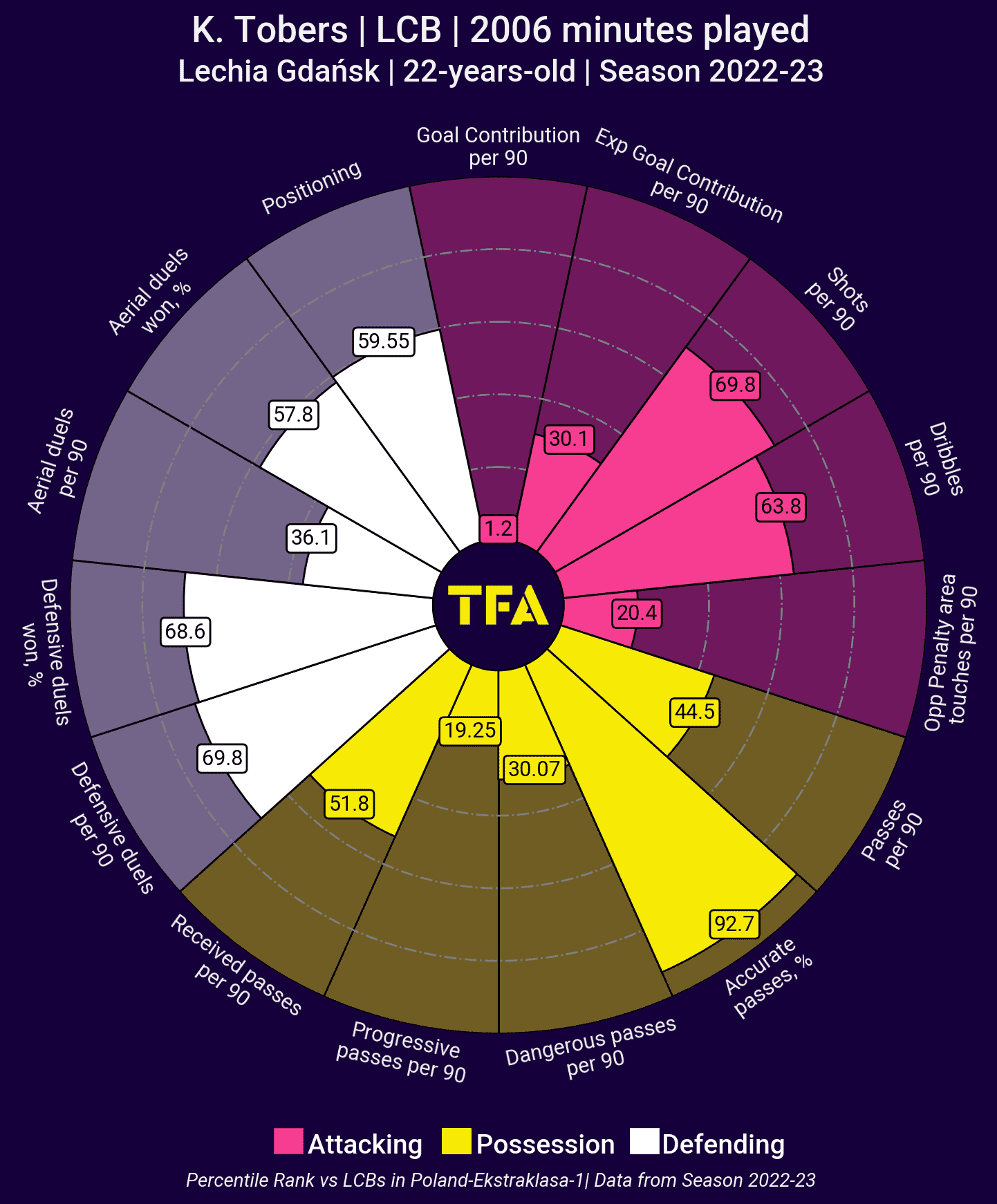
First up will be Kristers Tobers (189cm/6’2″) — a Latvian centre-back signed from Polish Ekstraklasa side Lechia Gdańsk. At 22, the defender leaves a lot of room for potential development. A right-footer, he primarily played on the left side of a back-four in Poland last season.
Tobers doesn’t offer a tonne as a ball-progressing centre-back, but this isn’t paramount to Berner’s backline anyway, though it’s a nice added bonus. Tobers demonstrated that he can be a safe, reliable passer in deep areas last season, as his high pass accuracy % rank on the above pizza chart indicates.
Tobers performed at a reasonable level in Ekstraklasa, as highlighted by his high ranking in defensive duels per 90, defensive duel success percentage, and positioning (a combination of tackles and interceptions).
The big Latvian is also a reliable defender in the air and could provide a threat from set-pieces — an area that Berner has spoken about trying to capitalise on to make marginal gains in the past.
Grasshopper don’t get the new Beckenbauer in Tobers, but they do get a solid, reliable centre-back who could be adequate for their current standing in Switzerland’s top flight.
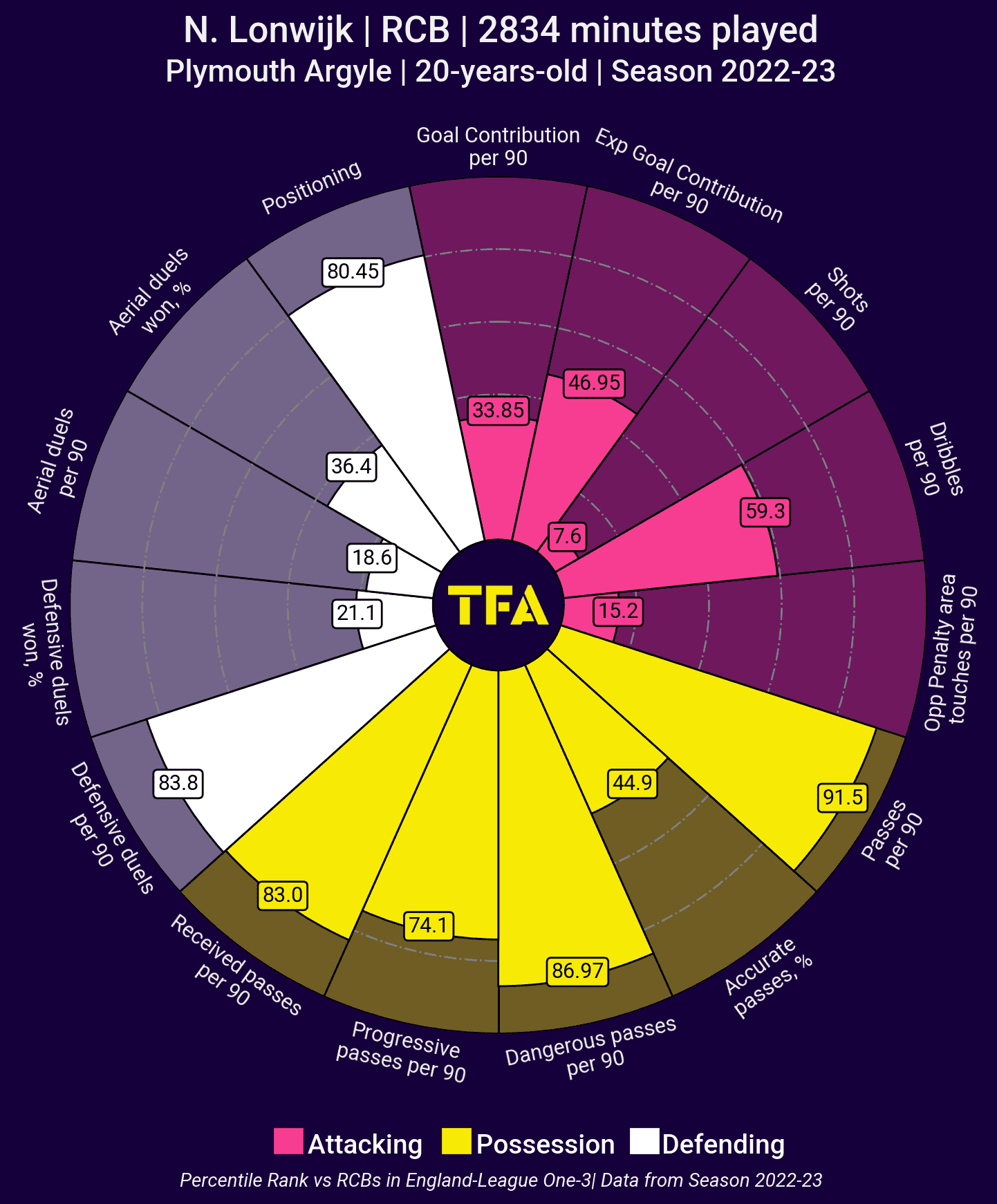
A more exciting defensive signing comes in the form of Nigel Lonwijk (189cm/6’2″) — on loan from EPL side Wolves and who was out on loan in the EFL League One last season, where he helped Plymouth Argyle to win the title.
Lonwijk primarily played as a right centre-back last season and possesses far greater ability on the ball than Tobers.
With Grasshopper this season, the 20-year-old has the potential to perform a similar role to that performed by right centre-back Yannick Schmid in Berner’s Winterthur team last season in that he’ll be very comfortable on the ball under pressure and help Grasshopper to carve through the opposition’s press quickly.
The Dutchman is also a player who’s comfortable defending very aggressively, actively pursuing forwards and looking to engage in defensive duels. I’d expect him to be an aggressor in the backline, perhaps with a full-back or his central defensive partner offering cover in behind to allow him to defend as he likes.
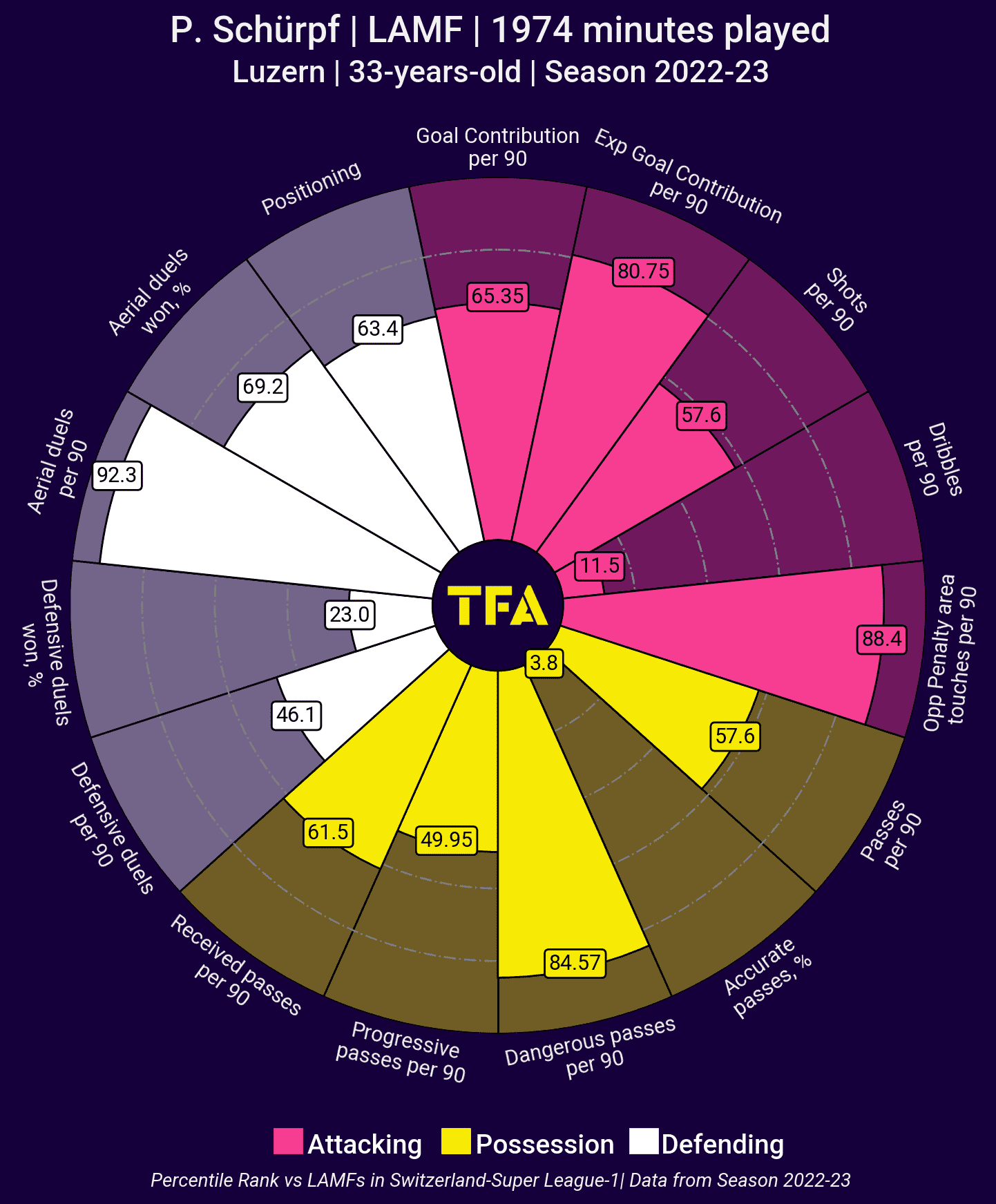
Another impressive signing is Pascal Schürpf (190cm/6’3″) from FC Luzern. The 33-year-old is comfortable playing as a left winger and would be ideal for the left winger role in Berner’s 4-4-2. In this team, Schürpf may actually end up replacing much of the output lost by the sale of now-former Grasshopper left-back/left-winger Dominik Schmid.
Schmid was a key creator within this Grasshopper side and played a lot of crosses from deep on the left wing and even from slightly more central positions after inverting slightly just on the edge of the final third. Schürpf has demonstrated a bit of a tendency to do the same thing and would surely have no problem in doing so more frequently if required by Berner and his new teammates.
His pizza chart shows that his dangerous passes and expected goal contributions are standout areas of his game. At the same time, at 190cm, Schürpf is also obviously a serious aerial threat.
Furthermore, as we mentioned, Berner’s wingers need a high work rate without the ball. Schürpf possesses this, with a decent number of defensive duels alongside good defensive positioning displayed on the pizza chart, which his new coach will appreciate. I’d expect Schürpf to be a significant player in and out of possession for Grasshopper this season.
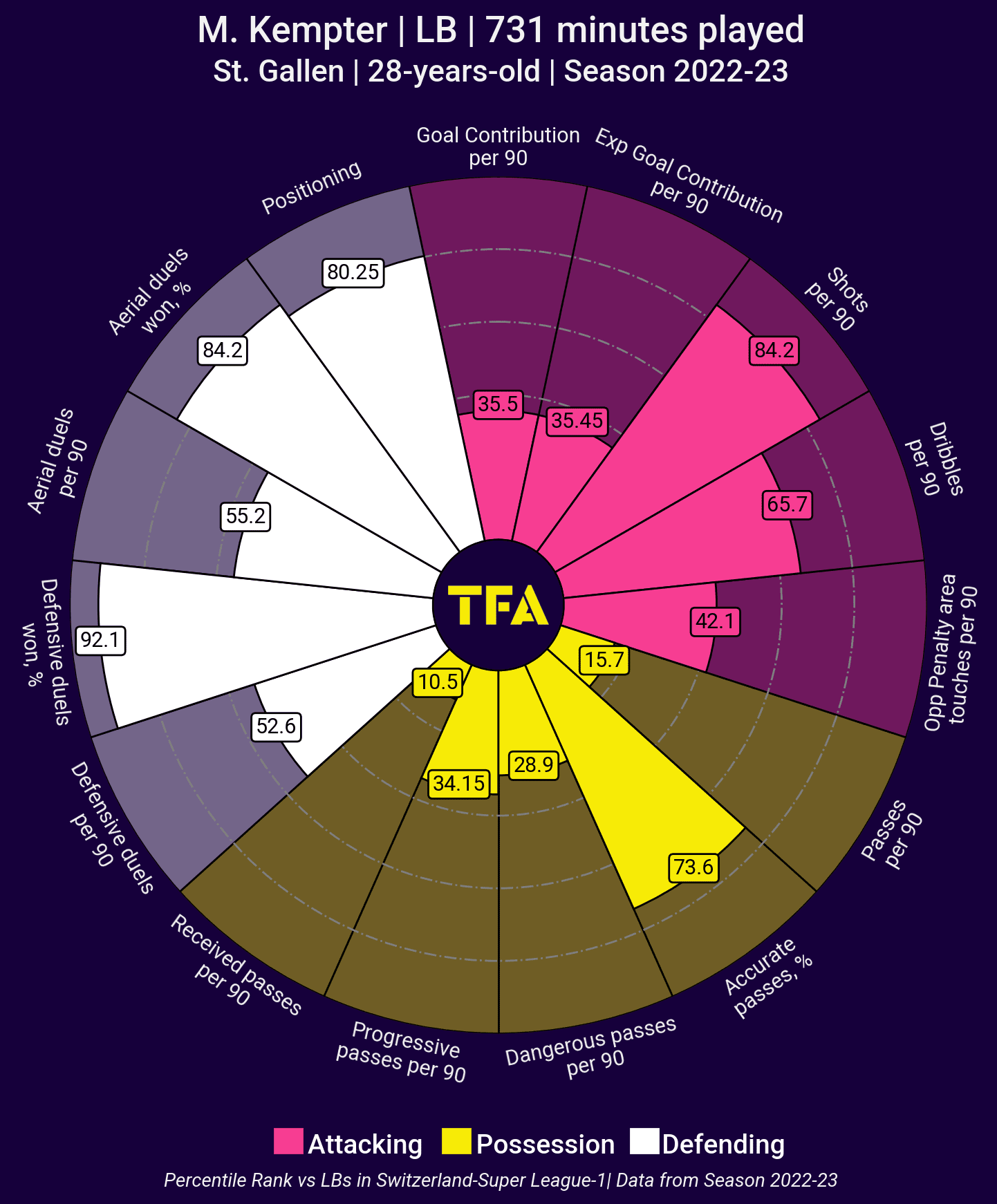
Grasshopper have also signed a left-back to replace Dominik Schmid’s name on the team sheet, place in the squad and provide defensive output in the form of Michael Kempter (181cm/5’11”), who joins from St. Gallen.
For me, Kempter and Schürpf can complement each other quite well on the left wing for Grasshopper, as Kempter is an excellent defender at this level but offers little going forward. However, if Kempter can find Schürpf in good positions, then Schürpf can take care of the defensive responsibilities. At the same time, Schürpf perhaps plays a more defensive role and may even tuck inside in possession to form a back-three, giving Schürpf the run of the left wing on the ball.
This is a dynamic on the left side that can work very effectively. Furthermore, we know Berner likes his team to defend aggressively in wide areas. Kempter’s solid defensive duel success % ranking highlights that there aren’t many more reliable full-backs than him regarding regaining possession in the Swiss Super League.
Conclusion
To conclude this tactical analysis, we hope we’ve given Swiss Super League, particularly Grasshopper supporters, a clearer idea of how they can expect their team to set up this season under new manager, the promising Bruno Berner.
We hope it’s clear from our analysis how Berner has enjoyed such success in the past as an overachieving coach, and our analysis has presented some useful ideas for how he may blend with his players this season and mould Grasshopper into his image. It’ll certainly be interesting to see if he can get this historic club competing at the right end of the table once again.





Comments